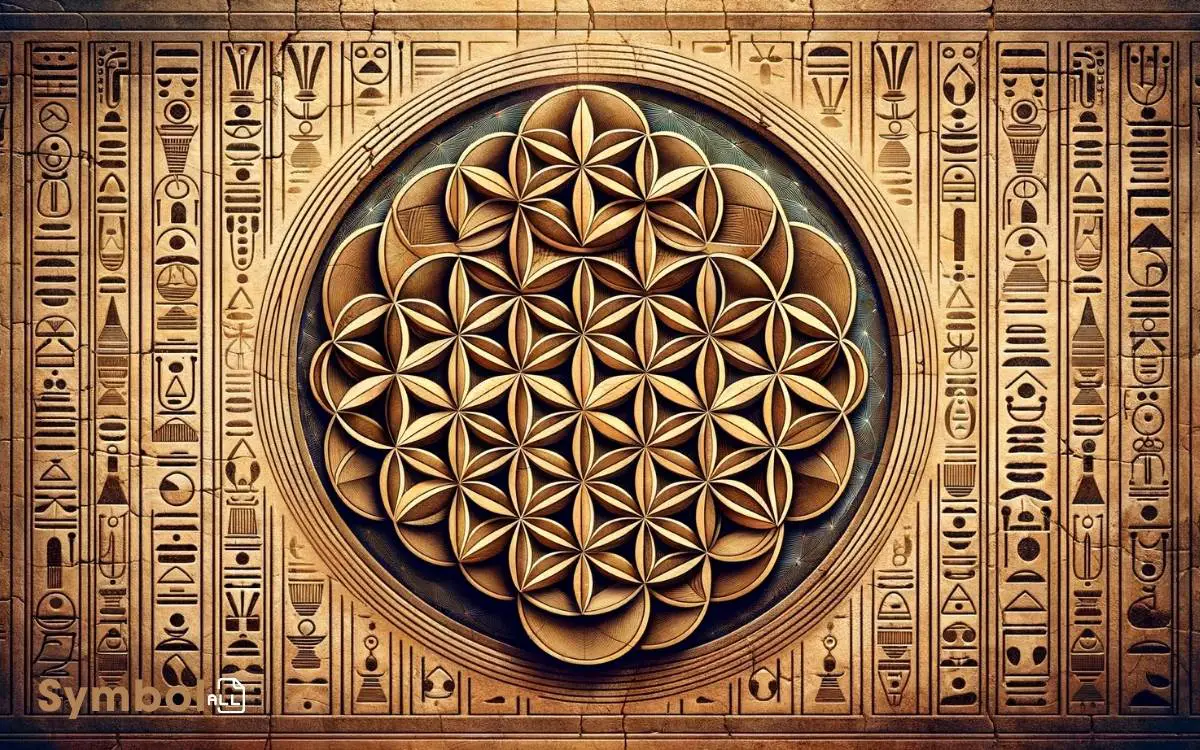Egyptian Symbol Flower of Life: Creation!
You’re exploring the Flower of Life, an ancient Egyptian symbol representing creation and interconnectedness. Its origins trace back to the temples of Osiris, embodying a sophisticated grasp of geometry.
This symbol, with its precise arrangement of circles, suggests a deep understanding of mathematical principles. It doesn’t just represent interconnected existence; it’s a cornerstone of spiritual philosophies, highlighting balance, harmony, and the cosmic blueprint.
Across cultures, it signifies the unity of life and the universe’s inherent patterns. Engaging with this symbol offers insights into universal harmony and philosophical explorations of existence. Uncovering its layers reveals profound connections across time and cultures.

Key Takeaways
Origins and History
Delving into the origins and history of the Egyptian symbol, the Flower of Life, reveals its profound significance in ancient civilizations, where it was revered as a symbol of creation and the interconnectedness of all life.
You’ll find that this emblem, consisting of multiple evenly-spaced, overlapping circles arranged in a flower-like pattern, wasn’t only pivotal in Egyptian culture but also held esteem across various societies around the world.
Its presence in ancient temples, manuscripts, and art underscores a universal reverence for the concept of life and the fundamental patterns of existence.
Geometric Structure
You’ll find that the geometric structure of the Flower of Life isn’t only intricate but steeped in mathematical precision.
Its pattern, when examined closely, reveals a complex arrangement of circles and shapes that have intrigued scholars for centuries, pointing to a deep understanding of geometry by ancient civilizations.
This structure’s mathematical interpretation, alongside its origin and history, offers a rich field for exploration, highlighting its profound cultural significance across different societies.
Mathematical Interpretation
At its core, the Flower of Life‘s geometric structure reveals a complex pattern of interlocking circles that mathematicians recognize as a visual representation of fundamental principles of space and time.
You’ll find that this structure isn’t just a random assembly of shapes. It’s meticulously arranged, demonstrating the concept of sacred geometry, which posits that certain geometric shapes have symbolic meanings and powers.
Delving deeper, each circle in the Flower of Life is congruent, signifying uniformity and harmony in the mathematical universe. The overlapping circles form a pattern known as the “seed of life,” a symbol believed to contain the blueprint of the universe itself.
This intricate arrangement allows you to explore the connections between geometry and the natural world, highlighting the inherent order and precision that govern our universe.
Symbolic Meanings
You’ll find that the Flower of Life‘s ancient origins provide a foundation for understanding its rich symbolic meanings, reflecting a deep connection to the concept of universal harmony.
This intricacy is further illuminated when you explore how these interpretations have been contextualized in modern times, revealing a continuity and evolution of thought.
Ancient Origins Explored
Many scholars agree that the Flower of Life symbol, deeply embedded in ancient Egyptian culture, embodies a complex set of mathematical symmetry and spiritual significance, reflecting the interconnectedness of the universe.
- The symbol’s origins trace back to sacred temple walls, where it wasn’t merely decorative but held profound esoteric wisdom.
- It’s closely associated with the concept of the Seed of Life, a precursor to the Flower’s full geometric array.
- Ancient texts hint at its use in meditative practices, aiming to reveal deeper cosmic understanding.
- The overlapping circles are believed to represent the cycle of creation, encapsulating the infinite nature of life.
- Its presence in various ancient civilizations suggests a shared understanding of its significance, transcending geographical and cultural boundaries.
Universal Harmony Concepts
The Flower of Life symbol embodies universal harmony concepts, intertwining mathematical precision with profound spiritual meanings to illustrate the interconnectedness of all existence.
This ancient emblem, composed of multiple evenly-spaced, overlapping circles arranged in a flower-like pattern, serves as a visual representation of the life cycle and the fundamental forms of space and time.
Its geometric design isn’t just aesthetically appealing but also symbolically rich, suggesting that all life and consciousness arise from one source.
This source, depicted through the symbol’s repetitive, cyclical pattern, mirrors the belief in a universe where everything is connected.
The Flower of Life’s intricate patterns are believed to represent the fundamental aspects of space and time, providing a visual expression of the complex relationships between all forms of creation.
Modern Interpretations Contextualized
Building on the universal harmony concepts, modern interpretations of the Flower of Life symbol explore its symbolic meanings within contemporary contexts, illuminating its relevance in today’s spiritual and scientific discourses. These interpretations often delve into the intricate geometry of the symbol, drawing connections between its patterns and fundamental principles of the universe, such as unity, balance, and interconnectedness. For instance, flower petal symbolism explained within the Flower of Life highlights how each overlapping circle can represent the growth and unfolding of consciousness. This blending of ancient wisdom with modern insights offers a bridge between spiritual reflection and scientific curiosity, making the symbol resonate across diverse fields of thought.
- Interconnectedness: It represents the interconnected nature of the universe, emphasizing how individual components are part of a larger, cohesive whole.
- Sacred Geometry: This symbol is a cornerstone in the study of sacred geometry, suggesting that fundamental shapes form the blueprint of our reality.
- Personal Growth: It’s seen as a map guiding individuals on their journey towards spiritual enlightenment and self-improvement.
- Healing and Protection: Many believe it possesses healing properties, offering protection against negativity.
- Scientific Exploration: Researchers investigate its geometric patterns, seeking insights into the fabric of space-time and the construction of the cosmos.
Cultural Significance
Delving into the cultural significance of the Flower of Life reveals its profound impact on various societies throughout history.
This symbol, consisting of multiple evenly spaced, overlapping circles, isn’t just a visual masterpiece; it’s a bridge connecting cultures across time and space.
Historically, it’s been discovered in the art, architecture, and sacred texts of civilizations as diverse as those of ancient Egypt, medieval Europe, and modern Japan, suggesting a universal appeal that transcends geographical and cultural boundaries.
Its presence in such a wide array of contexts highlights its role as a shared symbol of harmony, perfection, and interconnectedness.
Analyzing its ubiquity, you’ll find that the Flower of Life serves not only as a decorative element but also as a profound emblem of the unity underlying the world’s diversity.
Spiritual Interpretations
You’ll find that the Flower of Life‘s spiritual interpretations are deeply intertwined with the principles of sacred geometry, highlighting a profound connection to the fabric of the universe.
Recognizing how this symbol represents universal harmony, suggesting a cosmic balance inherent in all forms of life.
This perspective invites you to ponder the geometric pattern not just as an artistic motif but as a complex metaphor for the interconnectedness of existence.
Sacred Geometry Connection
Within the domain of sacred geometry, the Flower of Life symbolizes the fundamental patterns of space and time, embodying the interconnectedness of all life forms and spiritual entities.
This intricate symbol serves as a visual representation of life’s complexity and unity, inviting deeper contemplation on the nature of existence.
- Represents the cycle of creation: Illustrates how life emerges from a singular source.
- Blueprint for all structures: Believed to contain the patterns for everything in existence.
- Harmonic proportions: Emphasizes the universal patterns found in nature.
- Spiritual enlightenment: Serves as a tool for meditation, aiding in the understanding of the universe.
- Interconnectedness: Highlights the inseparable relationships between all forms of life.
Analyzing the Flower of Life through the lens of sacred geometry reveals profound insights into the fabric of our reality and our place within it.
Universal Harmony Concepts
Building on the understanding of the Flower of Life within sacred geometry, we now explore its role in illustrating concepts of universal harmony from spiritual perspectives. This symbol transcends mere geometry, embodying profound spiritual truths and insights.
It’s seen as a visual expression of the interconnectedness of all life forms and the fundamental unity underlying the universe.
| Emotion | Spiritual Concept | Flower of Life Connection |
|---|---|---|
| Awe | Interconnectedness | Infinite patterns |
| Peace | Unity | Harmonious design |
| Wonder | Creation | Seed of life stage |
Through this lens, the Flower of Life is not just a pattern but a sacred blueprint, offering a path towards understanding the intricate balance and harmony that pervades existence.
Its study encourages a deep, analytical appreciation of both the complexity and simplicity found in the natural world.
Scientific Perspectives
The scientific community’s examination of the Flower of Life symbol reveals intriguing intersections between ancient wisdom and modern geometric understanding.
You’ll find that this symbol isn’t only a piece of historical art but also a complex figure with significant implications in geometry and cosmology.
- The Flower of Life’s geometric pattern aligns with principles of sacred geometry, emphasizing the interconnectedness of all things.
- Its structure mirrors cellular patterns and growth cycles in nature, suggesting a universal blueprint.
- The symbol has been studied for its potential implications in theoretical physics, particularly in string theory.
- Mathematicians find its repetitive, symmetrical design useful in exploring tessellation and the Fibonacci sequence.
- Its spherical arrangement has parallels with the atomic structures and molecular bonds in chemistry, hinting at a microcosmic significance.
Understanding this, you grasp the depth of its scientific resonance.
Artistic Representations
Artistic representations of the Flower of Life symbol offer insights into its profound influence across various cultures’ visual languages, demonstrating how this ancient motif has been reinterpreted and integrated into art and architecture worldwide.
You’ll find it etched into the stones of ancient temples, serving not only as a decorative element but also embodying deeper spiritual and philosophical meanings.
Artists have drawn upon its geometric precision and symbolic richness to explore themes of interconnectedness, harmony, and the fundamental structures of the universe.
Its presence in manuscripts, sculptures, and paintings reveals a timeless fascination with the pattern’s perfection and the mysteries it encapsulates.
Through these artistic endeavors, the Flower of Life transcends its origins, becoming a bridge between the tangible and the ineffable, inviting contemplation and interpretation across epochs.
Modern Usage
In today’s digital age, the Flower of Life symbol continues to resonate, adapting to modern platforms and influencing a wide range of artistic and technological fields.
You’ll find its presence:
- In logo designs, where it’s used to convey concepts of harmony and interconnectedness.
- Within digital art installations, often as an immersive element that engages viewers on a spiritual level.
- As a motif in fashion, where designers incorporate its patterns into clothing and accessory lines.
- Throughout social media, serving as a symbol for wellness and mindfulness communities.
- In user interface (UI) designs for apps focused on meditation and personal growth, where its geometry is believed to promote calmness and focus.
This enduring symbol’s seamless integration into contemporary culture underscores its timeless appeal and versatility, bridging ancient wisdom with modern expressions.
Mathematical Connections
Delving into its mathematical connections reveals how the Flower of Life‘s geometric design embodies complex principles of symmetry and proportion.
At its core, this symbol consists of multiple, evenly spaced, overlapping circles that arrange themselves in a flower-like pattern with a sixfold symmetry.
This symmetry isn’t just aesthetically pleasing; it mirrors the natural organization found in cellular structures, crystals, and the macrocosmic planetary orbits.
Each circle in the pattern can be seen as a node, a point of intersection that mathematically represents the Vesica Piscis, a symbol of the divine feminine.
The geometry within the Flower of Life is foundational to the construction of Platonic Solids, considered the building blocks of our universe.
These connections underscore a profound relationship between geometry and the physical world, offering insights into the fundamental structures that compose our reality.
Healing and Meditation
Beyond its intricate geometric patterns, the Flower of Life serves as a powerful tool for healing and meditation, offering profound spiritual benefits to those who engage with its symbolism.
This ancient symbol, deeply embedded in various cultural traditions, facilitates a connection with the inner self and the universe. It’s not merely an object of visual appeal but a catalyst for deep introspection and harmony.
- Harmonization of Body and Mind: Aligns physical and mental states, promoting overall well-being.
- Enhanced Concentration: Aids in focusing the mind during meditation, fostering clarity.
- Emotional Balance: Helps in releasing emotional blockages, leading to emotional stability.
- Spiritual Awakening: Facilitates a deeper understanding of oneself and the cosmos.
- Energy Amplification: Believed to amplify surrounding energy, making it beneficial in healing practices.
Engaging with the Flower of Life in meditative practices encourages a holistic approach to healing, emphasizing the interconnectedness of mind, body, and spirit.
Global Influence
While exploring the multifaceted benefits of the Flower of Life on individual healing and meditation, it’s also imperative to examine its widespread impact on cultures and societies around the globe.
The Flower of Life’s geometric pattern hasn’t only been a cornerstone in the spiritual practices of ancient Egypt but has also permeated various cultures, symbolizing the interconnectedness of all life forms.
Its influence extends to contemporary art, architecture, and even modern spirituality, intertwining ancient wisdom with new-age thought.
This universal symbol’s adoption across diverse cultures underscores a collective yearning for understanding the intricacies of existence and unity.
Analyzing its global influence reveals a fascinating tapestry of cultural exchange and adaptation, highlighting the Flower of Life’s role in fostering a deeper, cross-cultural appreciation of life’s sacred geometry.
Conclusion
In the intricate dance of geometry and symbolism, the Flower of Life weaves a tale as ancient as civilization itself.
You’ve journeyed from its enigmatic origins in the sands of Egypt to its modern embrace in healing circles worldwide, observing its transformation from a sacred emblem to a universal symbol of interconnectedness.
This symbol, marrying mathematics and spirituality, serves as a bridge between the tangible and the ethereal, inviting you to explore the profound depths of human consciousness and the cosmos.






